Newsletter 150, March 2024

In this issue
NZFFA Conference 2024 “Resilient Landscapes”
NZFFA Annual conference, 9 - 13 April 2024
If ever there was a year that called on resilience, it was this one, so it is only fitting the theme of the 2024 New Zealand Farm Forestry Association Annual Conference is resilient landscapes.
The national conference will showcase examples and initiatives to help farmers improve sustainable land use, increase biodiversity and champion a resilient environment.
Notices
Levy referendum process
The “Harvested Wood Material” commodity levy needs to be renewed every six years by referendum. NZFFA have been advised by the Forest Growers Levy Trust Secretariat that the timetable requested by MPI for the referendum is 6-8 months ahead of the normal timetable. The sector has been requested to complete the consultation and referendum process by Oct 2024. This means we need to prepare quickly.
The Executive Committee have formed a Working Group of Neil Cullen, Vaughan Kearns, Graham West, Howard Moore, and Hamish Levack to manage the process and consult with members on issues and provide clarification. An advisory paper has been developed from discussions and shared with NZ Forest Owners comment plus sent to ten senior members for early feedback and calibration. A revised paper will be provided to all Branch Chairpersons and Councillors on Wednesday 26th March.
A major theme for this advisory paper is the desire to improve the functioning of the Levy to give better outcomes and ensure fairness in the benefits that accrue. Important issues are; setting the levy rate, achieving equitable representation, funding NZFFA, and improving the research strategy.
Two Webinars (web seminars) will be run for all members, one on Tuesday 2nd April at 7.00PM and another on Friday 5th at 4.00PM. Please read the paper and ask questions of the Working Group anytime. The levy referendum will also be discussed at the National Council Meeting at Napier on 10th April, starting at 8.00AM. There will be a notice to council that a relevant motion will be proposed.
Graham West
NOTICE OF UPCOMING ELECTION.
On 8 January nominations were called for the election of executive members at the 2024 AGM. There were only two vacancies, namely:
- SOUTH ISLAND EXECUTIVE MEMBER (Three-year term)
(with Laurie Bennett retiring by rotation) - NORTH ISLAND EXECUTIVE MEMBER (Three-year term)
(with Tim Forde retiring by rotation)
Only Laurie Bennett has been nominated to be the South Island executive member for the three years commencing from the finish of the 2024 AGM.
However, there are two nominations for the position of North Island Executive member for the three years commencing from the finish of the 2024 AGM. These are Tim Forde and Dougal Morrison.
Their short curricula vitae are appended. Councillors will be asked to vote for which of them they prefer at the NZFFA AGM in Napier in April.
Rules for voting:
The councillor for any Branch or Special Interest Group can vote.
Depending on the number of members enrolled in the branch, or special interest group, represented by the councillor, that councillor can exercise 1 or more votes according to the formula:
| 1 to 50 members | 1 vote |
| 51 to 100 members | 2 votes |
| 101 to 150 members | 3 votes |
| There after 1 vote for every unit of 50 members or part thereof. | depends |
Hamish Levack Secretary, NZFFA
Appendix Curricula vitae of the candidates.
Tim Forde 06 858 4222 or seeforde@xtra.co.nz writes "I am a dedicated member of NZ Farm Forestry Assn and have been a member since 1980. I presently own and run a 210-hectare farm in Central Hawkes Bay that consists of 170 ha of bull beef, 30 ha of commercial pine forest and 10 ha of agro-forest containing predominantly poplars. I have been milling and marketing poplar timber for at least 9 years.
My commitment to Farm Forestry in the last 40 years has firstly been on the Wairarapa Branch committee for 12 years, serving as President for 8 years. Secondly, I have been a member of HB Branch for over 30 years, serving on committee for the last 15 years and as President for the last 7 years.
Four years ago, I was asked to join the Strategic Development Group trying to analyze the falling membership and NZFFA general direction and from this involvement I was elected North Island Rep on the Executive 3 years ago. I am putting myself up for re-election as I feel there is more to complete. I am very supportive of the existence of NZFFA and will endeavor to strengthen and grow the organization into the future. As an active forester and member, I feel I have a lot to offer."
Dougal Morrison 027 470 0658 or dougalgbmorrison@gmail.com is a graduate of Lincoln University with a BAgCom and has post graduate forestry qualifications. He is currently working as a consultant to Groundtruth, a forest and land use consultancy business. He is a partner in a private forestry partnership in the Wairarapa, which is part way through being harvested. Eighteen hectares of the 135-hectare forestry block has been replanted in dryland eucalypt species. He has farmed for over 20 years, and is now retired from farming. As a farmer he planted many areas of alternative tree species.
Dougal is a member of both the Wellington and Wairarapa branches of NZFFA and has been a co-opted member of the National Executive of NZFFA for two years. He is also a member of the NZ Institute of Forestry and a member of the NZ Association of Resource Management, recognised as a Certified Practising Resource Manager (Leading Professional).
Events
For more information on these events, they are posted on the NZFFA website »
Branch secretaries, please make sure you notify head office of any branch or action group events.
- Harvesting Small Forest Blocks - Port Albert Tuesday 4 April 2024 9.30am to 2pm Perrin Ag would like to invite you to the second forestry harvesting workshop on 4 April 2024. The workshop aims to help you confidently understand…
- Waikato Branch Field Day & AGM - Karapiro Saturday 6 April 2024 9.30am 271 Barker Road, Karapiro, Cambridge. Last farm on the left end of Barker Road. Farm visit and tour followed by a discussion with the Waikato…
- Improving information in S-map - Important updates on soil water storage characteristics. Tuesday 9 April, 11.30-12pm. S-map is New Zealand’s authoritative source of information about our soils. It’s much more than a “map” and provides access to rich information about how soils perform and should be managed. You can register to attend this webinar via this link: https://attendee.gotowebinar.com/register/5457541851286073430
- NZFFA Annual conference, 9 - 13 April 2024 If ever there was a year that called on resilience, it was this one, so it is only fitting the theme of the 2024 New Zealand Farm Forestry Association Annual Conference is resilient landscapes. The national conference will showcase examples and initiatives to help farmers improve sustainable land use, increase biodiversity and champion a resilient environment.
- Gisborne East Coast branch Field Day - Eastwoodhill Aboretum Monday 15 April 2024 9am. Tree Growers Tairāwhiti, Gisborne East Coast Farm Forestry Association are hosting a Field day Monday 15th April 2024 9am at Eastwoodhill Arboretum followed by lunch at the Visitors…
- Harvesting Small Forest Blocks - Wellsford Community Centre 30 April 2024 9.30am to 2pm. Perrin Ag would like to invite you to the second forestry harvesting workshop on 30 April 2024. The workshop aims to help you...
Advert: Treefarmer
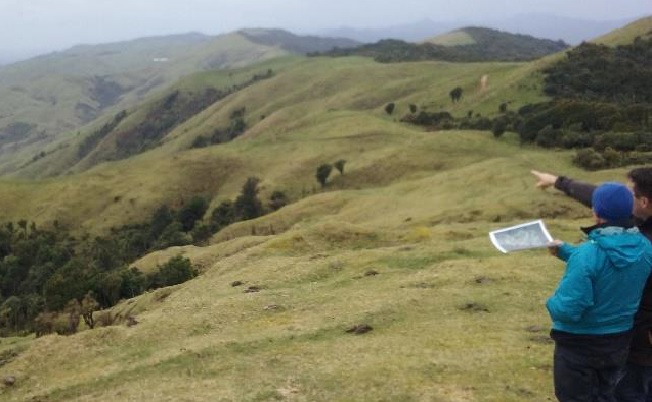
Treefarmer is a free web-based computer tool to assist landowners with woodlot planting and harvesting decisions.
Woodlot Planning
Multiple woodlots can be mapped on your property and the planting of five forestry species simulated. Choose from three tending regimes to give costs and yields (wood and carbon) for selected harvest age.
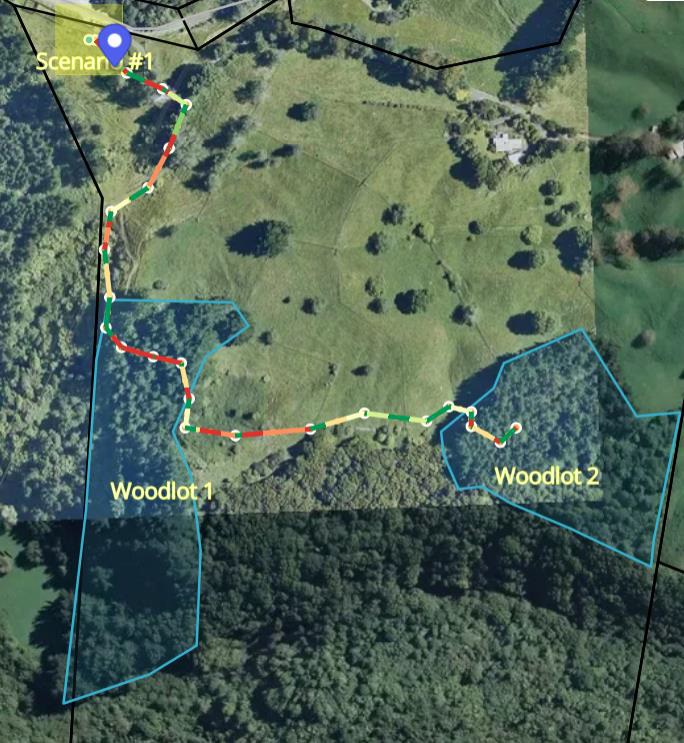
Tree Harvest
Multiple woodlots can be mapped, and the harvest planning simulated by drawing woodlot boundaries, skid locations and road scenarios.
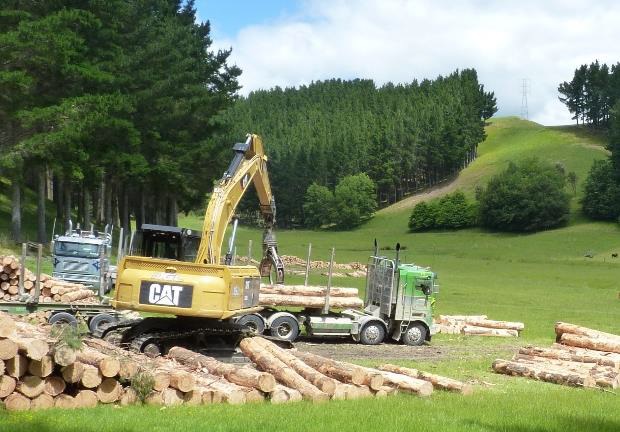 Access to the tool is available from Forest Growers Research ».
Access to the tool is available from Forest Growers Research ».
Tree Grower articles
- Extreme rainfall – forest flows The need for water resilient landscapes (Access: NZFFA membership)
Vanessa McWilliams, Dean Meason and Grace Villamor, February 2024
Extreme weather is becoming more common. Knowing where the water is, where it is going and who gets to use it are the three main questions which the forest flows… - In the wake of the Council (Access: NZFFA membership)
Howard Moore, February 2024
We are now in the useful habit of holding a Council meeting each November to help ensure everyone knows what we are trying to do and why. This article is… - Stay slim – own a forest (Access: NZFFA membership)
Howard Moore, February 2024
Anxiety keeps me slim. I know in my heart that things would be much better if I only had the time, money and skill to fix them myself. This constant… - Elite hybrid cypress trial A full evaluation at age nine (Access: NZFFA membership)
Vaughan Kearns, February 2024
The first round of hybrid crosses of well-known cypress macrocarpa and lusitanica with the lesser known Alaskan yellow cedar Cupressus nootkatensis were made in 2004 by scientists and technicians at… - Biodiversity credits A submission from the NZFFA (Access: NZFFA membership)
Julian Bateson, February 2024
Members of the NZFFA have supplied information for a number of submissions over the last year or two. A very recent one was about the possibility of a biodiversity credit system.… - Substituting imported wood with New Zealand timber (Access: unrestricted)
Karen Bayne, Jonathan Harrington and Harriet Palmer, February 2024
A recent study by a Scion team looked into New Zealand’s timber imports, analysing the demand for timber from overseas. The study was instigated partly because of rising awareness of… - Does the Forest Growers’ Levy give value for money? (Access: unrestricted)
Stephen Franks, February 2024
Do you get value for money from the commodity levy on harvested wood? That was the editor’s real question when he asked me to explain what the Forest Growers’ Levy… - The training needs of small-scale forest owners (Access: unrestricted)
Eric Cairns and Julian Bateson, February 2024
In 2023, the NZFFA was granted funding from the Forest Growers’ Levy to investigate the training needs of small-scale forest owners. Our target audience also included pastoral farmers interested in… - Green, blue and grey The shades of water (Access: NZFFA membership)
Howard Moore, February 2024
In the last Tree Grower I suggested solving our methane problem by shooting lots of cows. Some of you may have thought I was being tough on farmers, but of… - Forestry under our new government (Access: NZFFA membership)
Hamish Levack, February 2024
Before the general election last October, the NZFFA asked the major political parties to provide their forest policies. Maybe it is a reflection of the forest sector’s inadequate promotion of… - Annual NZFFA Conference Hawke’s Bay – Napier War Memorial Conference Centre April 9 to April 13 (Access: unrestricted)
NZFFA, February 2024
The 2024 NZFFA Annual Conference is being held in Hawke’s Bay, based in Napier. It will be the highlight of the year for farm foresters and a chance to hear… - Australia and New Zealand Institute of Forestry conference (Access: NZFFA membership)
Dougal Morrison, February 2024
The joint Australia and New Zealand Institute of Forestry conference was held from 15 to 18 October 2023 at Tweed Heads, New South Wales, Australia. The theme of the conference… - President's Comment (Access: unrestricted)
Neil Cullen, February 2024
A new year and some subdued prospects for the forest sector. At the briefing ‘Situation and Outlook for Primary Industries’ last month, Director General Ray Smith predicted forest exports would… - New multi-species calculator (Access: unrestricted)
Mark Kimberley and Michael Watt, February 2024
A new multi-species calculator has been developed to help a tree grower make decisions. The calculator predicts growth for even-aged plantations of eleven different species. It also provides annual estimates… - The final cut for grant projects in 2024 (Access: unrestricted)
Julian Bateson, February 2024
The Forest Growers’ Levy has been reasonably kind to the NZFFA in recent years, approving a number of grants which have enabled work to be carried out to benefit small-scale owners.…
Headlines
- Emissions Trading Scheme fee review a relief for cost-struck foresters February, 2024. The New Zealand Forest Owners Association says the review of the Emissions Trading Scheme (ETS) fees is a relief for foresters facing excessive costs and loss of climate change action. …
Presidents Annual Report 2024 AGM
The past twelve months have been very busy for our Association. I have been very fortunate to have a great team working together to continue the workplan developed under Graham West’s leadership. As well as Graham contributing greatly as immediate Past-President there has been Vice-President Vaughan Kearns taking a big role in organising field trips and managing projects and generally supporting the President. Howard Moore as Treasurer also plays an invaluable part in keeping the Association running with his blunt wit and sage advice a key part of keeping meetings and projects on track. Our Secretary Hamish Levack and the team at FIAG have played an important if largely unseen role as a sounding board for ideas, ensuring projects are ran properly, and overseeing the Tree Grower production. The rest of the Executive and our Administrator Liz, have all played their part well in representing and running NZFFA.
At last years AGM there was much discussion on the proposal from Graham for reorganising the structure of our organisation with the aim of reducing the workload of the President, engaging the Council more, and using contractors and or a Operations Manager to manage operational matters. A modified version of this has been adopted. At the November Council meeting I appointed Graham as Chair of the Council as is currently allowed in the Constitution and he and Vaughan have taken a more prominent leadership role in assisting the President, representing the Association, and initiating talks with other forestry groups than would previously have been the case. Dougal Morrison was engaged as a contract manager for the 18 Opportunities From Trees Workshops and from last month we have contracted Matt Highway as a part time Operations Manager.
Matt will initially concentrate on building connections to government agencies, establishing partnerships with other forestry bodies, and obtaining funding for a website upgrade. An important ongoing objective will be to find alternative sources of funding for the Association so that an Operations Manager can be employed on a longer term. With his experience, connections, and enthusiasm for NZFFA Matt is a welcome addition to our team and he is looking forward to meeting many of you at Conference.
The change of government in November has brought many policy reversals or alterations for our sector, some good some not so favourable. With the Emissions Trading Scheme, the Minister has announced an independent inquiry into the proposed annual charges of $30.25 per hectare for participants which seem unjustified and a severe disincentive for small scale foresters. Whilst the carbon price is currently stable there are many unanswered questions about the scheme and how it will be managed in future in regard to forestry. There needs to be broad agreement between Government and the Climate Change Commission about the role of forestry both exotic and indigenous in meeting our emission targets and avoidance of policy flip flops which are so frustrating for a sector trying to look 30 plus years ahead. I echo our pan industry advice to the incoming Minister that we need bipartisan commitment to stable ETS settings and clearly set out minimum planting expectations from the government.
The Industry Transformation Plan for the Forest Sector that had industry wide support has been unfortunately dropped by the new government but many of its aims can be continued through various other initiatives. The Alternative Species Workshops that NZFFA is currently holding around the country in conjunction with MPI are an example of this. It appears the TUR/NZ Forest Service Advisory Service will survive the current ministerial cutbacks which is good news for us as they are a natural and welcome ally in promoting forestry on farms. The constraints on all parts of our economy but especially government spending means finding other sources of income whether through sponsorship, partnerships, or government programmes is especially challenging at present.
The downturn in forest harvesting during 2023 has meant less levy income to spend in all areas including the services NZFFA supplies to small scale growers. With the vote on levy renewal coming later in the year we have been re-examining the MOU and Services Agreement that were signed by NZFFA and Forest Owners Association at the start of the Forest Growers Levy and have begun talks with FOA to try and get back to the partnership and regular meetings that existed then. Negotiations on the changes we would like to see to the levy management will be part of those discussions.
2023 saw the emergence of a new pan-sector group the NZ Forest & Wood Sector Forum. Its purpose is to provide a body for the ten signatory associations to engage on issues of common interest or concern and where appropriate act as spokesperson and point of contact for the industry with Government and other relevant bodies. NZFFA is a member and supports the concept of a strong whole of industry voice. Regular meetings are scheduled with the MPI Director General and staff and the Minister when available.
Continuing our strategy of lifting the profile of the organisation, we had a large presence at the National Fieldays Forestry Hub last June. With that experience and the resources available from there we have this year set up shop at the Southern Field Days and also at the Central North Island at Feilding. A lot of volunteer time is required by Exec and local members for these activities which so far seem justified by the number of new members recruited. We will be at Mystery Creek again this year and then make a judgement on which venues we target in future.
Communication with our members is being improved with more regular digital newsletters. Material from branch newsletters is being incorporated in this monthly production and co-ordinated by Dean Satchell. We are grateful for Dean’s ongoing management of the website. The Tree Grower continues to be stand out forestry publication under the editorship of Julian Bateson. Submissions on our behalf on a number of topics including biodiversity credits, changes to the ETS, and the Tairawhiti Inquiry were completed. Each takes many hours of study and work and we salute those who put their hands up to take on those tasks.
So a lot achieved in the past year in modernising our Association and keeping it relevant in a fast changing world. From a farming point of view the integration of trees into farms to increase their viability and sustainability has never been more important and this is recognised by organisations such as Beef & Lamb and MPI who want to support and work with us. We need to continue the efforts to recruit a new generation of farm foresters and find new income streams to fulfil our role as promoters of wise land use.
Neil Cullen
Alternative species field day, Cullen farm, 14 March 2024
The NZFFA, with support from TUR/NZ Forest Service, are holding 20 sessions across the country to showcase alternatives to pine. The South Otago event was held at the Cullen family farm, Glenomaru Farm Ltd, on 14 March, and was the first to take place.
And what a great event it was. Such a beautiful property, so carefully tended, it was a pleasure to look around.
Attendees numbered between 30 to 40, a combination of SOFFA members and others interested in alternative species. The Industry Transformation Plan for forestry would like to see 20% of plantings in alternatives to pine, to mitigate the risk of pine monoculture. Also, NZ imports 50,000 cubic metres of timber from overseas each year, and this is a good candidate for replacing with our own-grown timber.
Neil Cullen gave us an introduction to the farm and some of these species. The farm has been in the family since 1968 and has a land area of 650 ha, currently with 90 ha in radiata and 68 ha in other trees, planted on poorer land and steeper hills. There is 130 ha of indigenous cover in a QEII covenant. 96 ha is registered in the ETS and Neil wondered whether to add another four hectares which would entitle him to use the Field Measurement Approach (FMA) whereby the farm would get its own specific carbon tables based on measured plot growth which can be up to 20% higher than the non-FMA carbon tables.
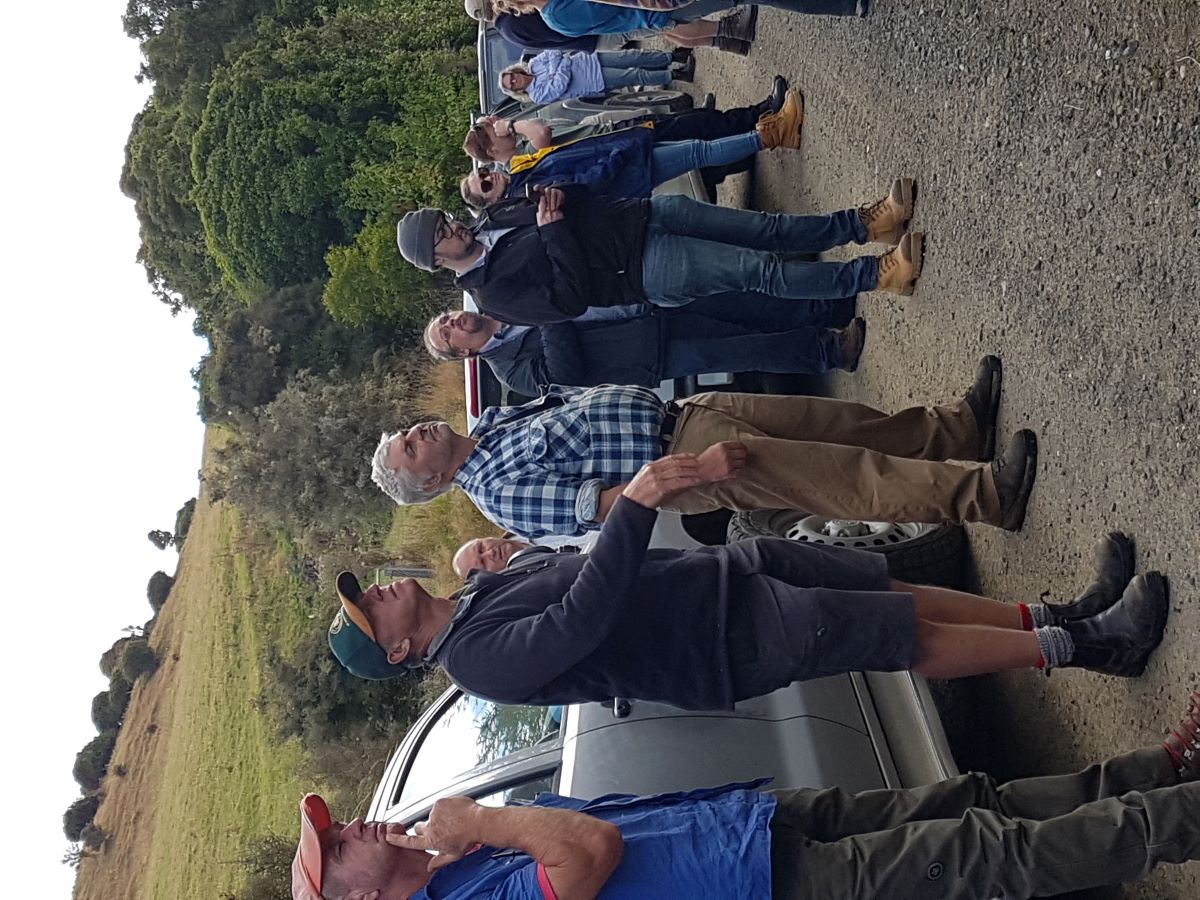
Neil gave us brief details on the other species on the farm. Douglas-fir is not so widely planted these days because of the wilding problem, but it produces structural-grade wood used for export and the local market, and has a 45-year rotation. There is no need to prune it as it is used for framing grades. It handles snow well, and grows good volume, but is not suited to very coastal areas as it doesn’t like salt wind. It needs a good rainfall. On the downside it does not take preservative treatment very well.
The ash group eucalypts are fast growing, easily pruned, can be used for biofuel, have options for timber and export to China. However, no-one mills eucalypts in the lower South Island and it is difficult to dry, needing to be covered up after cutting, and dried slowly for up to a year.
Neil also grows some durable eucalyptus which are frost tolerant and used for non-chemically treated posts or timber.
Coastal redwoods are attractive with their good form, but need pruning. The timber is moderately durable and gets sent to the USA as decking and cladding. The growth rate is similar to pines, with very few disease issues. They grow big volumes – the species is the tallest tree in the world – but are slow to establish and are site selective.
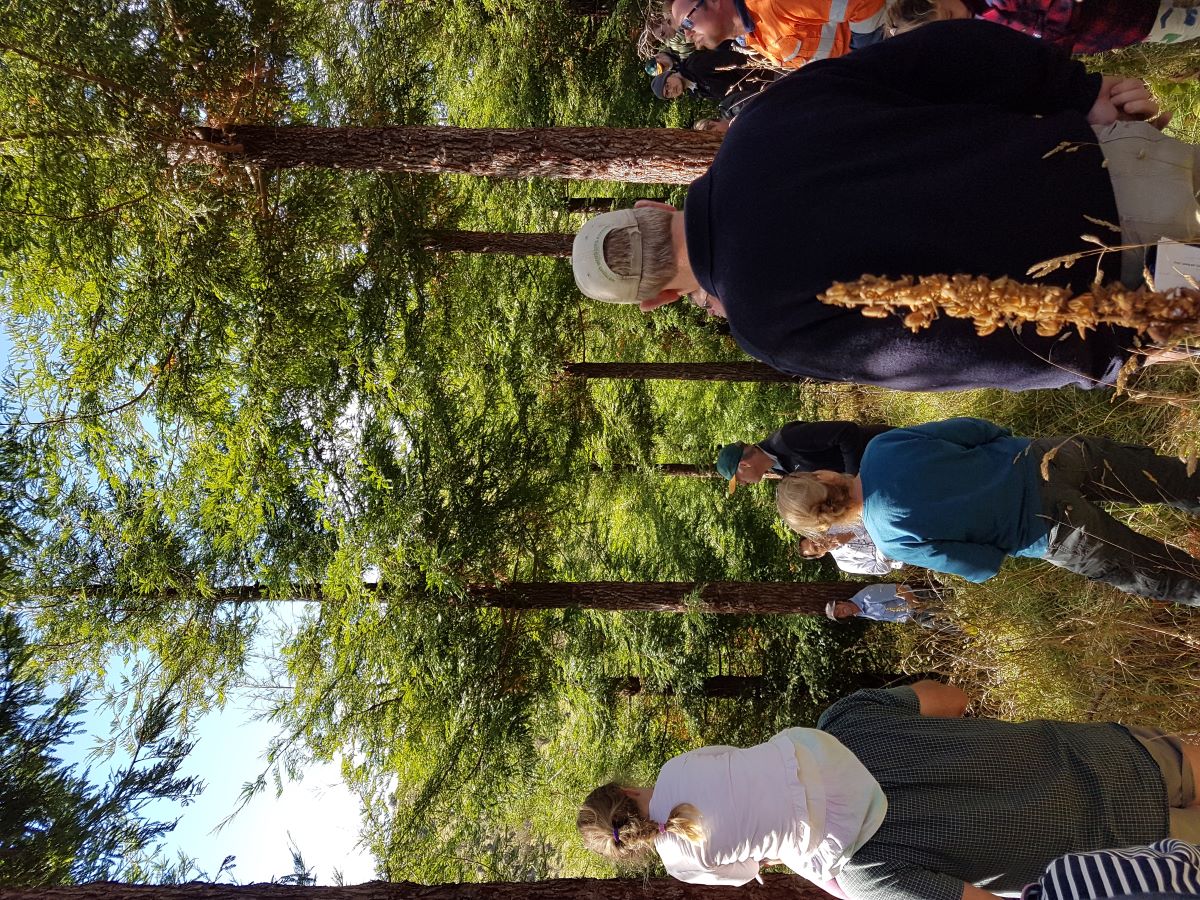
In the coast redwoods
Japanese cedar is similar to redwoods but more wind hardy.
Neil has found that red beech, a native hardwood, is also a viable option as an alternative species. This has a possible 50-60 year rotation. There has been very little work done on selection for form and growth with this species.
Sitka spruce is another alternative, but unfortunately this is targeted by an aphid which defoliates the trees in spring and causes some to die.
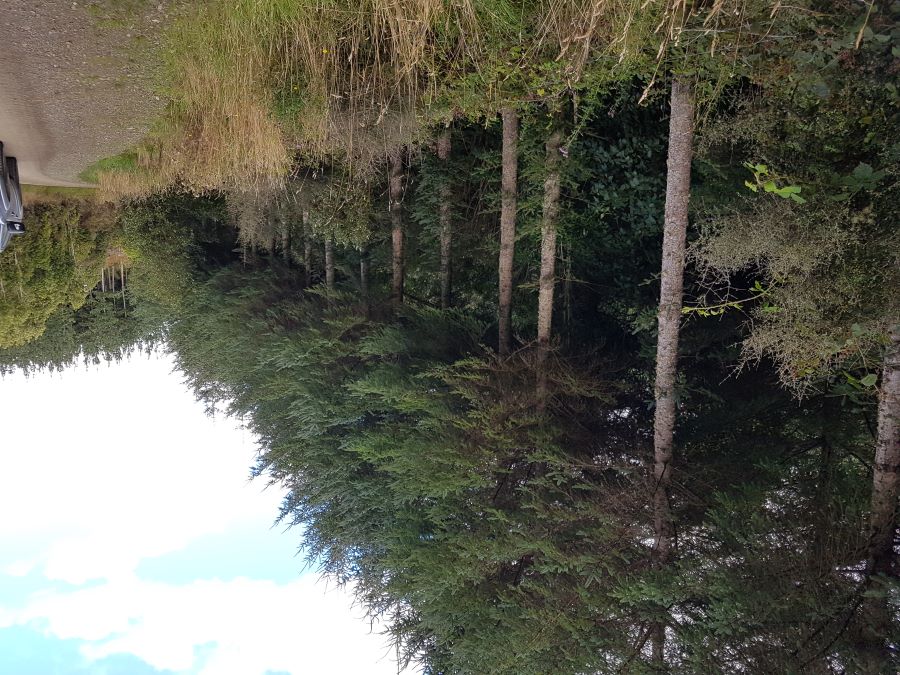
Sitka spruce
Finally, hybrid larch (a Japanese/European larch cross), which is faster growing than European larch. This wood is durable and recognized in the building code. As the tree is deciduous, it gives a nice colour when the seasons change.
Then on to the farm tour and a myriad of stops to view some of these trees in action, so to speak. We passed by a 5 ha block of 32-year-old pine which was being logged by Nathan Stuart of Stuart Timber in Tapanui. 65% of the logs are going to local mills – Stuarts, PanPac, and Otago Lumber – and the rest are being exported. Neil is harvesting 600 tonnes/ha, a good amount. The creek crossing in the block being logged was put in ten years ago, a drop deck culvert costing $60,000 then, but still cheaper than a bridge.
Carrying on, we looked at a 50 ha valley, of which 35 ha was planted in 10 different species in 2011 (no radiata), and the rest is native.
A stand of coastal redwoods is now 13 years old, at 700 sph, and pruned. Neil has a farm worker who has been doing silviculture across the farm for 40 years. Apparently redwoods are easily pruned, with soft wood. They don’t mind growing close together but will coppice from stumps. Neil has set up his plantings as coupes which can be harvested from the top of the valley, as the land is too steep otherwise.
There are permanent sample plots around the farm, which will help improve the accuracy of the carbon tables for alternative species.
We viewed blocks of different eucalypts. One, of fastigata, was at 400 sph and Neil considered this was still too high even though they had been thinned. He finds that euc blocks are good for transitioning to native cover. Cordata flowers during winter, providing food for tuis. A shelterbelt of the johnstonii eucalypt looked good, but this is not often planted now as it’s a favourite of the paropsis beetle pest.
We also looked at blocks of cypress of different types, and Douglas-fir. In the middle of a grass paddock stood two matai trees which Neil reckoned were 400-500 years old. It is great they have been kept.
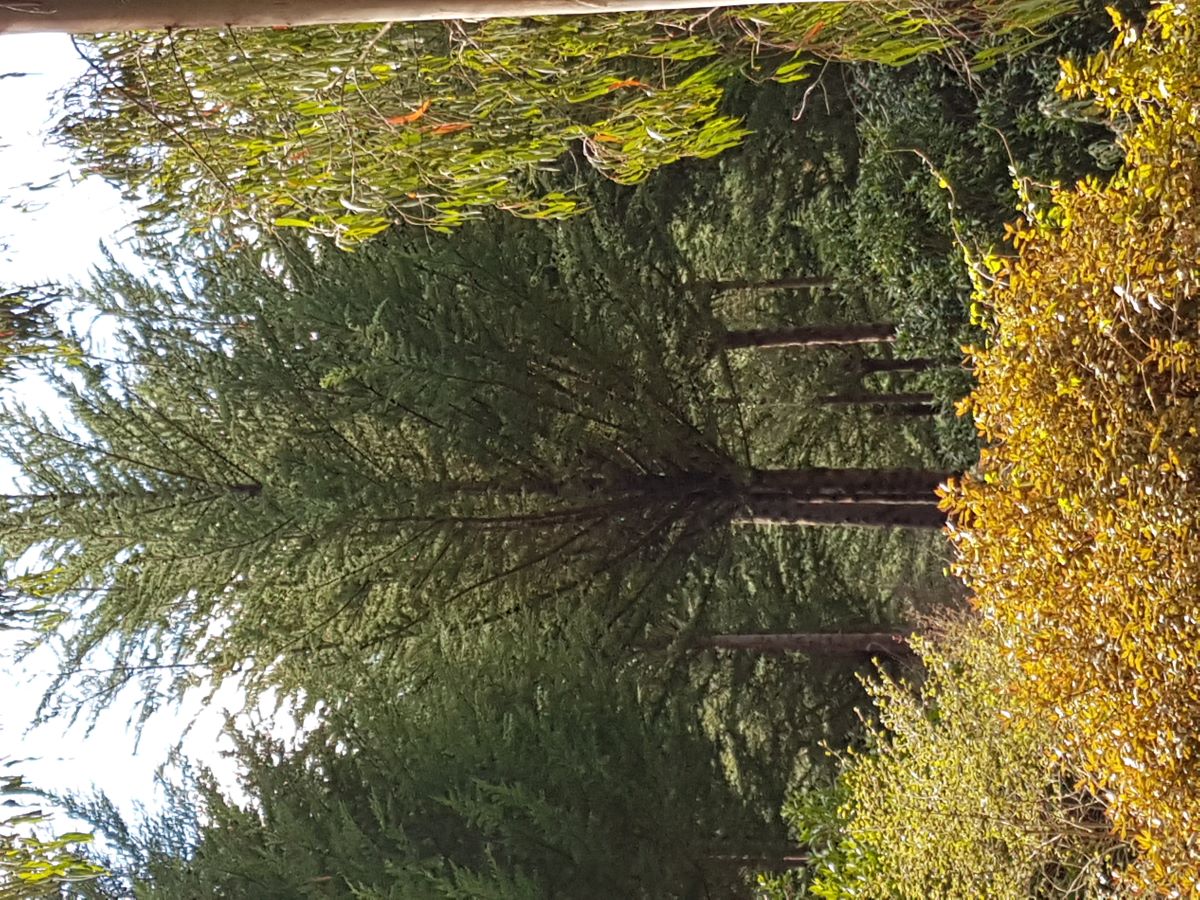
Cypress hybrid
Back at the woolshed, afternoon tea was served, then beer and BBQ (thanks again Robin!). Hopefully the afternoon will have given farm foresters some ideas about what might work on their own farm. In any event, it was a treat to see the Cullen farm, and a big Thank You to Neil, Pam, Simon and family for letting us see around it.
Fiona Lomax
|
President: Neil Cullen president@nzffa.org.nz Newsletter editor: Dean Satchell dsatch@gmail.com National Office: Liz Chamberlain admin@nzffa.org.nz Phone: 04 4720432 |
Members |
| Disclaimer: Personal views expressed in this newsletter are those of the writers and do not necessarily represent those of the NZ Farm Forestry Association. | |
